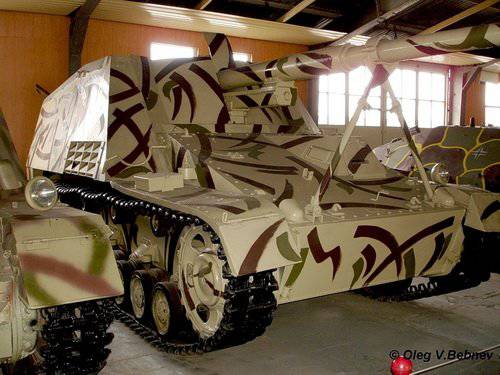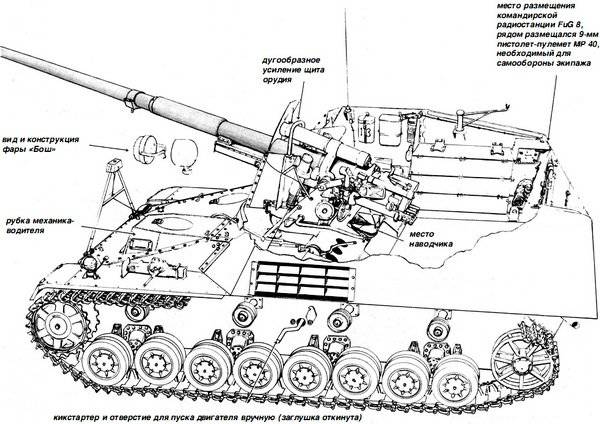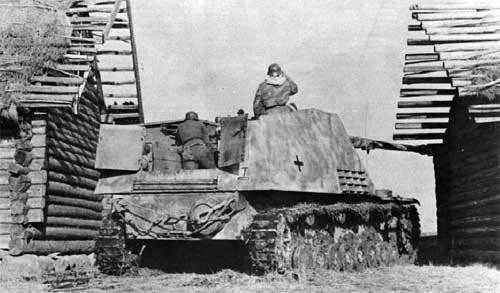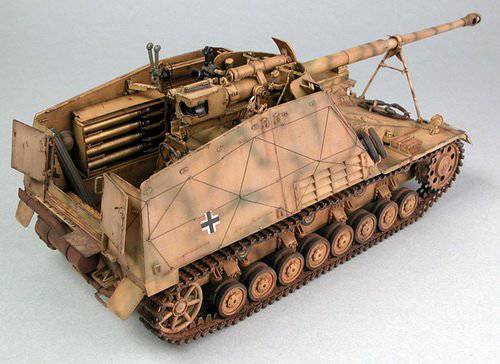Anti-tank SAU of Germany during the war (part 7) - Nashorn
In 1943, on the Eastern Front, German troops faced the problem of deploying new anti-tank cannons 43 / 1 X-gun caliber 88 mm. They were supposed to form the basis of the Wehrmacht anti-tank defense. These guns had a wheeled carriage and were too heavy (weight about 4,5 tons), for this reason they lacked tactical flexibility. In order to change the firing position, it was necessary to attract special equipment for towing and a large number of people. All this was enough to significantly reduce the advantages of this tool.
That is why the German army got on the agenda the question of how to make this weapon self-propelled. For this purpose, the Pz IV tank was taken as the basis. At the same time, the gun was too heavy for him and even with the use of wide caterpillars the specific pressure on the ground was quite large. Therefore, talk about any serious booking SAU did not even stand. At that time, Germany was already experiencing a shortage of high-quality steel, which is why the already weak booking of the Nashorn ACS was worsened by using uncured steel, which made the self-propelled guns more vulnerable.

The high silhouette, which the Hummel self-propelled gun had, built on the basis of a self-propelled gun carriage, the Geschtitzwagen III / IV, was uncritical for it, as it fired from closed positions. However, this deficiency to the tank destroyer significantly complicated life, and masking the car turned into a very nontrivial task for the crew. Most often, Nashorn was used from positions that were at least 2 km away from the enemy. While the vast majority of tank destroyers were usually used with much smaller distances.
Taking this into account, the Germans gave priority in the production of the 150-mm self-propelled howitzer "Hummel". During the war years, 724 Hummel and 494 Nashorna were built. A powerful anti-tank gun with good ballistics made the Nashorn a formidable tank destroyer, while the self-propelled guns were too large and, unlike Ferdinand, did not have a counter-booking. Only the lack of specialized machines forced the Germans to use the "Rhino" as a tank destroyer. Toward the end of the war, the Nashorn was replaced by a more advanced PT-SAU Jagdpanther.
Design features
At the request of the Arms Administration, the Berlin-based Alkett Company developed a hull of the same width as the PzKpfw III armored hull (slightly wider than the PzKpfw IV tank). Components and aggregates of the new ACS, including the drive wheels, differentials and transmissions were taken from the PzKpfw III tank. Engine with cooling system, radiators and silencers from the average tank PzKpfw IV Ausf.F. The elements of the self-propelled vehicle chassis: support and support rollers, tracks of tracks, sloths were also borrowed from the PzKpfw IV.
The Nashorn ACS was equipped with the Maybach 12 gasoline engine HL120TRM. V-shaped carburetor engine with a collapse of cylinders in 60 degrees had a working volume of 11 867 cm3 and developed maximum power in 300 hp at 3 000 rpm The engine was mounted in the central part of the SAU housing, and the “flooring” above it was maximally strengthened in order to place an artillery gun without problems near the center of gravity of the “Nashorn”.

The fuel was placed in 2 tanks with a total volume of 600 liters. The tanks were placed under the bottom of the fighting compartment, and their filling openings were located inside the fighting compartment. Thus, refueling could be carried out even under enemy fire. Also in the bottom of the case were special drain holes, which should in the event of an emergency remove fuel from the SAU case. These devices were closed by the crew only in the case of forcing water obstacles ford.
Crew SAU consisted of 5 people. In front of the corps, in the isolated wheelhouse, the ACS mechanic-driver, 4, a member of the crew, including the commander, were in the fighting compartment. They were covered with thin armor plates in front, behind and from the sides. From above the cabin was open; if necessary, a tarpaulin could be stretched on it.
Spacious fighting compartment was located in the stern of the ACS. The barrel of the cannon was at a height of 2,24 m above the ground, which at least 0,6 m exceeded the standard level when placing the gun on its standard cruciform carriage. It was too much height that was the main drawback of Nashorn. The side walls of the fighting compartment were installed vertically and had only 10 mm. thickness, therefore, could not provide the crew with reliable protection. The head plate of the cabin had a good ballistic profile, but its reservation also did not exceed 10 mm. A distinctive feature of the ACS was the blinds of the engine air intake, which were located on both sides of the wheelhouse approximately in the middle of the machine body. They were located above the fenders and were slightly buried inside the crew compartment. In general, the Nashorn ACS was a successful carrier for the anti-tank 88-mm gun, although it was very vulnerable in direct fire.

The NNSX-mm StuK 88 / 43 X-gun (a self-propelled version of the 1 / 43 X-gun) with a long barrel in 1 caliber was installed in the cabin of the Nashorn ACS along with the top of the gun carriage. Structurally, it was similar to the towed version of the gun, but the shape of the gun shield was rounded in order to allow the gun to rotate inside the wheelhouse. The gun had a recuperator (recovery - the return of energy that is consumed during technological processes), which was mounted above the gun barrel, the nakatnik was placed under the barrel. On the sides of the gun were special counterbalancing cylinders. In the vertical plane, the gun had angles from -71 to + 5 degrees. The horizontal guidance sector was 20 degrees (30 degrees in both directions).
The main part of the gun ammunition, which consisted of 40 shells, was located in the racks of the fighting compartment on the sides of the wheelhouse. The gunner had several sighting devices, including a panoramic artillery sight. For self-defense at the SAU, the MG-34 machine gun was used, and the crew also had at least two MP-40 submachine guns.
use Features
The self-propelled guns “Nashorn” were used as part of specialized battles of tank destroyers (Panzerjaeger Abteilung). Such divisions were independent combat units that were not part of the organizational structure of tank divisions. All of them were handed over to the corps or army headquarters and were attached to various units in the form of reinforcement as needed.

Divisions armed with ACS Nashorn possessed high mobility and, despite the weak armor protection of the crew, often did not need the support of tanks. In addition, with their appearance, the Wehrmacht infantry units received at their disposal mobile and better protected (in comparison with field anti-tank guns) means of anti-tank defense and fire support. Most often, these anti-tank ACSs were used for battalions, rarely on one front could you see the whole part, it only happened in extraordinary cases. The highest efficiency, being the most powerful fire weapons when firing direct fire at a distance of up to 3,5 km, was achieved by the self-propelled guns when a communications and observation platoon was included in the division, which was supposed to detect the enemy in time and notify the crews.
Most often, when interacting with the tanks, the Nashorn ACSs followed their battle formations at a sufficient distance and sought to suppress the ACS and enemy tanks from ambushes and pre-selected positions. They were also often used as a mobile anti-tank reserve, the composition and strength of which varied based on the situation. In general, they served as a combined means of defense and attack, both in interaction with tank and infantry units of the Wehrmacht. In fact, the crews of PT-SAU Nashorn, maintaining a certain distance of the battle, had the opportunity to carry out various combat missions, quickly moving from one tactical device to another. They could attack from an ambush, use the “hit-retreat” method, cover a false retreat, and so on.
Performance characteristics: Nashorn
Mass: 24 t.
Dimensions:
Length 8,44 m., Width 2,95 m., Height 2,94 m.
Crew: 5 people.
Reservations: from 10 to 30 mm.
Armament: X-NUMX-mm cannon StuK88 / 43 L / 1, 71-mm MG-7,92 machine gun
Ammunition: 40 projectile, 600 ammo.
Engine: 12-cylinder gasoline liquid-cooled engine “Maybach” HL 120TRM, HP 300 power.
Maximum speed: on the highway - 40 km / h
Power reserve: 260 km.
Information